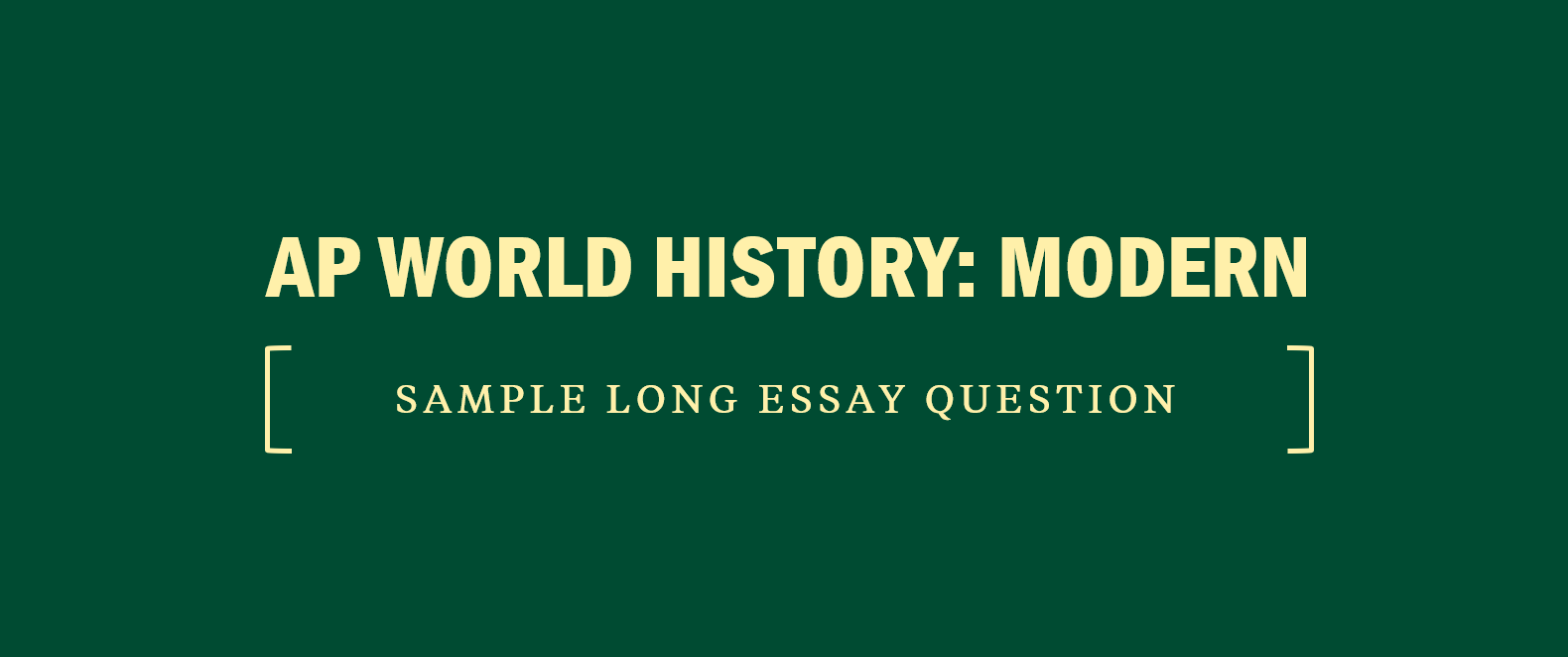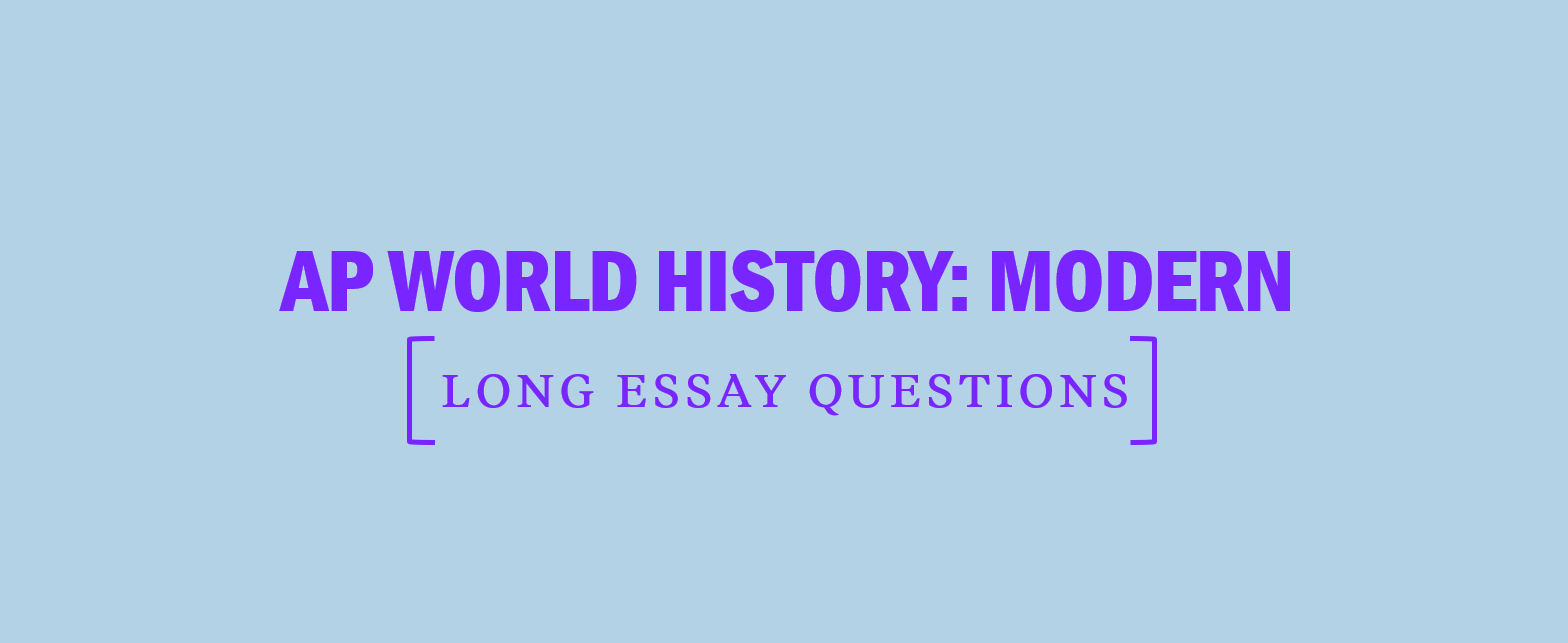
- AP Calculus
- AP Chemistry
- AP U.S. History
- AP World History
- Free AP Practice Questions
- AP Exam Prep


AP World History: Modern Sample Long Essay Question
In the period 1850 to 2001, new technologies emerged that had significant social, political, and economic effects. Develop an argument that evaluates the extent to which changes in the spread of ideas/information before and after World War I impacted societies.
Step 1: Analyze the Prompt
As you choose which question you will answer, begin thinking about what your thesis will entail and how your essay will demonstrate a complex understanding. The notes of a sample high- scoring writer are below. Note that the writer plans to develop a complex argument by addressing not only changes, as required by the prompt, but also continuities in societies before and after World War I.
Thesis : changes: faster spread of ideas made news, politics, and war more immersive and fast-paced; continuity: cross-cultural interactions transform all cultures (complex understanding, historical skill)
Step 2: Plan Your Response
- Context : Gutenberg → 2nd industrial revolution (steamship, train, telegraph) → digital revolution (radio, TV, Internet)
- Thesis : changes: faster spread of ideas made news, politics, and war more immersive and fast-paced; continuity: cross-cultural interactions transform all cultures ( complex understanding, historical skill )
- Evidence : War of 1812 versus WWII, Vietnam, Gulf War
- Evidence : American Revolution versus Cold War
- Evidence : language: Arab traders & Swahili, and modern business & English
- ¶ conclusion: impacts of tech on society have become more pervasive, though tendency towards cross-cultural influence has persisted
Step 3: Action! Write Your Response & Step 4: Proofread
Sample high-scoring response.
A key change between these eras of communication is how the speed of ideas’ dissemination impacts their force of impact and makes news more pervasive in civilians’ lives. In the distant past, the slow rate of communication caused reactions that were often months, or even years, after the initial communication. For instance, the final battle of the War of 1812 was fought after the signing of the war’s peace treaty because news had not yet traveled by ship across the Atlantic Ocean. In contrast, the peace treaties of WWII were celebrated in cities around the world mere minutes after news of their signing was shared by telegram and radio signals. The quick spread of images and video from the Vietnam conflict helped intensify Americans’ resistance to the war. In recent decades, 24-hour live coverage of conflicts, as in CNN’s being the first to provide constant coverage of a war during the Gulf War, allowed policy- makers and civilians to respond instantly to developments. As news became quicker, so its impact became more significant and more immediate.
Another change is that the quick and pervasive spread of ideas has made political conflicts more ideological and propaganda-based, further drawing societies into global disputes. Political rebellions of the eighteenth century, such as the American and French Revolutions, were based on Enlightenment ideals such as equality and representative government; they made use of propaganda in the form of printed political cartoons, tracts, and engravings to spread their ideals among the populace. However, the news communication made possible by radio and television after World War II helped propel the ideological conflict between the communist Soviet Union and the democratic United States into a worldwide phenomenon that intensely impacted both nations’ citizens. Technology was able to so effectively spread this war of ideas that the two major superpowers never engaged in direct battle themselves; still, citizens were drawn into a culture of propaganda that demonized the other side, made bomb shelters and bomb drills a part of daily life due to fear of nuclear warfare, and saw governments pour millions of dollars into the space race. Technology thus made it possible for conflicts to become all-immersive, even if they were based on ideas rather than physical confrontations.
Despite changes in communication, constants about its impacts remain. Cross- cultural communications still transform societies as they borrow and adapt ideas from others. For instance, from the eighth century onward, Arab traders who traveled throughout West Africa and along the eastern and northern coasts not only enriched communities economically but also spread Islam. Further, the necessity for communication among traders led to the rise of Swahili, a language that combined Arabic and African words and is still the lingua franca in much of East Africa today. Similarly, in modern times, as Britain and then the United States dominated world trade, English became a kind of worldwide lingua franca of modern business. Just as Arab traders spread their religion, American culture also diffused to other societies: almost every nation in modern times, for instance, built American-style fast food restaurants. Mirroring the trends related to the spread of news and politics, cultural diffusions in recent decades occurred at a faster rate and to a more pervasive extent than in the past. Whereas primarily traders would have adopted Swahili as it developed over generations, today English is taught in grade schools throughout the world.
Cultures that interact always influence each other. In the past century, how- ideas travel at a faster pace. As they have in ever, technology has made the impact of this spread of ideas more pervasive and significant as news and political the past, societies will continue to transform as they encounter ideas from other cultures, but with this increased intensity of communication, the impacts of ideas will continue to escalate.

You might also like

Call 1-800-KAP-TEST or email [email protected]
Prep for an Exam
MCAT Test Prep
LSAT Test Prep
GRE Test Prep
GMAT Test Prep
SAT Test Prep
ACT Test Prep
DAT Test Prep
NCLEX Test Prep
USMLE Test Prep
Courses by Location
NCLEX Locations
GRE Locations
SAT Locations
LSAT Locations
MCAT Locations
GMAT Locations
Useful Links
Kaplan Test Prep Contact Us Partner Solutions Work for Kaplan Terms and Conditions Privacy Policy CA Privacy Policy Trademark Directory

IMAGES
VIDEO
COMMENTS
What role did nationalism play in the fight for independence? Before WW2, nationalism was a powerful unifying force all around the world. It had been a major cause of WWI with Serbian …
This APUSH LEQ example will show you exactly how to answer the long essay question. Learn how to write a high-scoring essay on the AP exam.
The long essay question on the AP U.S. History exam is designed to test your ability to apply knowledge of history in a complex, analytic manner.
This essay provides a historically defensible thesis, relevant contextualization, specific evidence, and a well-structured analysis, earning a perfect score according to the AP World LEQ Rubric.
LEQ Cheat Sheet Outline Paragraph 1: (Indent) Thesis: Must respond to the prompt with a historically defensible claim that establishes a line of reasoning about the topic. To earn this point, the thesis must make a claim that responds …
Examples of acceptable thesis: “The rapid evolution of technology through the middle to end of the 19th century fostered great technological change in the United States.
Examples of acceptable theses (hypothetical): • “The Columbian Exchange had a profound impact on the Americas most notably by diversifying American populations through migrations …
Test your AP knowledge with a sample AP World History: Modern Long Essay Question. Get strategies, answer explanations & more.